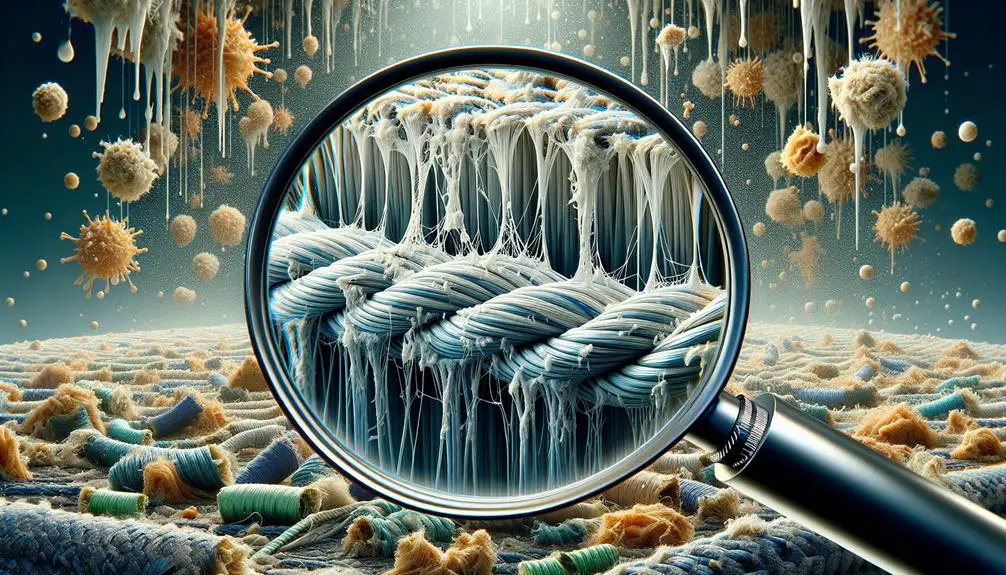I've found out that nylon isn't as tough as it seems when faced with certain enemies. UV light from the sun can really break it down. High heat softens nylon, making it less reliable, whereas water starts a process called hydrolysis that weakens its very structure. A big no-no is stretching nylon too far; overdoing it can permanently damage it. Also, rubbing and heavy load exposure are not great for it either. Plus, storing it wrongly in hot, humid places, or near harsh chemicals speeds up how quickly it falls apart. There's a lot more to learn on keeping nylon strong.
Table of Contents
Key Takeaways
- UV light exposure accelerates the breakdown of nylon, causing brittleness.
- High temperatures and humidity initiate hydrolysis, softening nylon and weakening its structure.
- Exposure to mineral acids degrades nylon, reducing its strength and durability.
- Mechanical stresses such as overstretching and friction cause permanent damage and weaken molecular bonds.
- Improper storage conditions, like high humidity and hot temperatures, accelerate nylon's degradation.
Effects of Sunlight Exposure
Sunlight exposure significantly weakens nylon by causing photodegradation. This degradation happens because UV rays from the sun break down the molecular bonds in nylon fibers. Over time, this means that my nylon items, like backpacks or outdoor gear, can lose their strength and durability.
Let's get into what really happens: when nylon is exposed to sunlight, those pesky UV rays start to break the polymer chains. This results in a loss of elasticity and tensile strength. I've noticed that my nylon fabrics also become brittle and discolored if I leave them out in the sun for too long. It's not just about the look; it's the material getting weaker.
To combat this, I use UV protectants or simply try to keep my nylon gear out of direct sunlight. It's a straightforward fix that helps extend the life of the material. Keeping nylon shaded or covered prevents the harsh sun rays from causing this photodegradation, ensuring my items remain functional and strong for as long as possible. It's a small step that can make a big difference in maintaining the quality of my nylon belongings.
Impact of High Temperatures
While sunlight poses its own risks, high temperatures also significantly impact the integrity of nylon. As I delve into the details, it's important to note how high temperatures affect this versatile material.
First, nylon softens when exposed to high temperatures, which can be a real issue for products that depend on its strength and durability. Whether it's gears in a machine or a simple zip tie, heat can make nylon lose its shape and effectiveness. This softening happens because nylon's molecules start moving more freely as the temperature approaches its melting point, which ranges from 374°F to 536°F.
Moreover, prolonged exposure to high temperatures leads to more severe problems like thermal degradation. This isn't just about a temporary loss of form; it's about permanent damage. Here's how thermal aging breaks down nylon's capability:
- Reduction in Strength: The material becomes weaker, making it less reliable for weight-bearing applications.
- Increased Brittleness: Nylon turns brittle, which means it can crack or shatter with minimal force.
- Loss of Performance: Overall, the material won't perform as expected, failing in crucial moments when durability is key.
Understanding these impacts helps in making better choices about using nylon in high-temperature environments.
Chemical Exposure Risks
In addition to temperature, chemical exposure significantly weakens nylon, affecting its durability and performance. Here's how different chemicals interact with nylon:
| Chemical Type | Effect on Nylon | Example |
|---|---|---|
| Mineral Acids | Can degrade nylon | Sulfuric acid |
| Organic Solvents | Generally no effect | Acetone |
| Alkalis | No harm to nylon | Sodium hydroxide |
Nylon's chemical resistance is notably strong against organic solvents and alkalis, which means it holds up well in many environments. However, mineral acids are a different story. These acids can break down the nylon fibers over time, leading to significant damage. It's crucial to understand which substances nylon can safely contact and which pose a risk to its integrity.
For instance, while handling or storing nylon products, ensuring they don't come into contact with strong mineral acids is vital. This precaution helps maintain the material's strength and longevity. Remember, the key to preserving nylon's properties is careful management of its chemical exposure. By knowing these interactions, we can prevent unnecessary degradation and extend the life of nylon products.
Overstretching and Deformation
Overstretching nylon fibers often leads to permanent damage and reduced functionality. When I push these fibers beyond their intended limits, I'm essentially testing the tensile strength that holds their structure together. Sadly, exceeding this limit not only weakens the fibers but also risks snapping them altogether. This isn't just about a temporary loss of form; it's about a lasting change that affects how the material performs in everything from clothing to industrial applications.
Here's what happens:
- Loss of Elasticity: The first casualty of overstretching is the spring-like quality of nylon. It no longer snaps back into shape, making it less useful where flexibility is key.
- Weakening of Material: Continuously pushing past the tensile strength means the nylon starts to fray and weaken. This makes it more susceptible to tearing or breaking under normal conditions.
- Altered Structural Integrity: Overstretching modifies the crystalline structure of the nylon. This alteration downgrades its overall strength and durability, impacting its performance severely.
Nylon's mechanical properties are its backbone in many applications. By understanding the consequences of overstretching, I ensure that I use materials appropriately to avoid deformation and preserve the integrity of my projects.
Moisture and Humidity Concerns
As I explore the effects of moisture on nylon, it's clear that hydrolysis significantly impacts the material's durability.
Humidity also plays a role in degrading nylon, making it less reliable over time.
The challenge of moisture absorption further complicates how nylon maintains its strength and shape under varying environmental conditions.
Hydrolysis Impact on Nylon
Water contact significantly weakens nylon through a process called hydrolysis, which rapidly degrades its molecules. This isn't just a minor annoyance; it's a critical vulnerability that affects the durability and reliability of nylon products. When nylon is exposed to water, it undergoes hydrolysis, leading to molecular degradation and a loss of structural integrity.
Here's what you need to know:
- Water Exposure: Direct contact with water initiates a chemical breakdown, stripping nylon of its strength.
- Molecular Degradation: The breakdown process affects the very building blocks of nylon, making it less durable.
- Structural Integrity: As the fibers degrade, the material's ability to withstand stress diminishes, leading to failures in applications where dependability is crucial.
Understanding these impacts helps in mastering nylon's limitations and uses.
Humidity's Degradation Effects
Building on how water impacts nylon, it's also important to consider how humidity contributes to its degradation. When nylon is exposed to humid environments, it undergoes hydrolysis, which significantly weakens its structure. This process involves the interaction of water molecules, specifically hydrogen cations and hydroxyl anions, with the nylon, leading to the breakdown of its molecular bonds.
Here's a quick overview of how humidity affects nylon:
| Factor | Impact on Nylon |
|---|---|
| Hydrolysis | Accelerates degradation |
| Humid Environment | Increases susceptibility |
| Molecular Structure | Compromises strength |
Understanding this can help in taking the right measures for nylon care and storage, preserving its strength and functionality in humid conditions.
Moisture Absorption Challenges
Nylon's tendency to absorb moisture presents significant challenges, particularly in how it affects its strength and durability. Due to its hygroscopic nature, water absorption leads to several issues:
- Dimensional Instability: Moisture absorption causes nylon to change in size, which can be problematic in precision applications.
- Reduced Strength: When exposed to moisture, nylon's structural integrity is compromised, leading to a decrease in its overall strength.
- Electrical Insulation Loss: High humidity and moisture can degrade nylon's excellent insulating properties, increasing risks in electrical applications.
Understanding these impacts is crucial for anyone relying on nylon in environments prone to high humidity or moisture. It's not just about knowing the material but mastering how to handle its limitations.
Wear and Tear Over Time
As I explore what weakens nylon, it's clear that wear and tear over time plays a crucial role.
Repeated mechanical stress, like constant folding or stretching, really takes a toll on nylon's durability.
Environmental factors, such as prolonged sun exposure or high temperatures, also significantly degrade its strength and appearance.
Repeated Mechanical Stress
Repeated bending or stretching gradually weakens nylon through wear and tear. As I've learned, this mechanical stress disrupts the molecular bonds that hold nylon together. Here's how this damage unfolds:
- Bending and Stretching: Each time nylon is flexed or elongated, tiny breaks in the molecular bonds occur. These aren't visible, but they're surely there, weakening the material bit by bit.
- Friction and Abrasion: Constant rubbing or scraping against surfaces causes surface damage, exacerbating the weakening process.
- Overloading: Stretching nylon beyond its capacity causes significant damage, pushing the fibers past their breaking point.
Unfortunately, these seemingly small stresses accumulate, leading to a notable reduction in strength and durability. It's a slow but sure process that demands careful handling to maintain nylon's integrity.
Environmental Degradation Effects
Environmental factors like UV light and humidity gradually degrade nylon, compromising its structural integrity over time. I've observed that UV light exposure specifically accelerates the breakdown of the polymer structures within nylon, leading to a notable decrease in its durability.
| Factor | Effect on Nylon | Outcome |
|---|---|---|
| UV Light | Degrades polymer structure | Reduced durability |
| Humidity | Initiates hydrolysis | Weaker bonds |
| Chemical Exposure | Attacks nylon fibers | Lessened strength |
| Temperature Fluctuations | Stresses material | Increased wear |
These environmental challenges ensure that nylon doesn't last indefinitely. Each factor, from hydrolysis due to moisture to chemical exposure, plays a significant role in how nylon wears over time.
Improper Storage Conditions
Storing nylon improperly can significantly weaken its durability and performance. Over time, I've learned that the types of conditions nylon is kept in are crucial for maintaining its integrity. Here's what I've discovered can happen:
- Exposure to Sunlight: Nylon stored in direct sunlight suffers. The UV radiation breaks down the fibers, leading to brittleness and loss of strength.
- High Humidity Levels: When nylon is kept in damp environments, it absorbs moisture. This mightn't seem like a big deal, but it actually leads to weakened fibers and reduced elasticity.
- High Temperatures: Storing nylon in hot areas can accelerate its degradation. The heat affects the molecular structure, causing the material to lose its resilience and strength more quickly.
I also take care to avoid any contact with harsh chemicals. These substances can be devastating, causing the nylon to break down at a much faster rate than under normal conditions. It's not just about keeping it away from intentional chemical exposure; even vapors from common household cleaners can be harmful if nylon is stored without proper ventilation.
Understanding these factors has taught me the importance of careful, considerate storage to maintain the quality and functionality of my nylon items.
Frequently Asked Questions
What Breaks Down Nylon?
In discussing what breaks down nylon, it's key to note that water, UV light, and oxidation are major culprits. Poor-quality dyes and constant wet conditions speed up this degradation process significantly.
What Can Damage Nylon?
I've found that UV light, high temperatures, harsh chemicals, frequent friction, and moisture can all significantly damage nylon. Each factor uniquely impacts the durability and integrity of nylon products.
How Does Nylon Degrade?
Nylon degrades primarily through hydrolysis, where water breaks down its polymer chains. This process weakens nylon by reducing its strength, making it less durable under stress and environmental conditions.
What Factors Affect Nylon Properties?
Factors affecting nylon's properties include exposure to UV light, contact with water, and exposure to acids. These elements can degrade the material, impacting its strength and durability over time.
- Why Is Red Velvet Not Red? - April 25, 2024
- How Do You Describe Velvet Fabric? - April 25, 2024
- How Strong Is Velvet? - April 25, 2024








